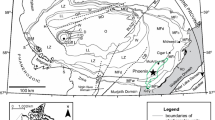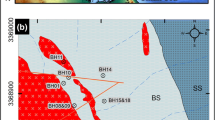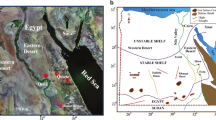Abstract
A prospective lithochemical survey (scale 1:50,000) was carried out at the Um Garayat gold mine area within the central wadi Allaqi shear zone. The metavolcanic samples were analyzed for Ti, P, Zr, Nb, Y, La, Nd, and Ce. The background and threshold values were determined using histograms, box-plots, and Q-mode cluster analysis. Discriminant analysis classifies the samples into four groups: Group 1 (Au mineralization) characterizes Phase III of the hydrothermal stage; Group 2 (Cu–Au mineralization) characterizes Phases I and II; Groups 3 and 4 comprise the least altered samples. Cubic trend surface and residual maps display groups of elements: (P, Ti, Zr), (Nb, Y), and (La, Nd, Ce) each group has similar areal distribution pattern. R-mode factor analysis, using the cubic residuals, produces a model with three factors. Factors 1 (P, Ti, Zr) and 2 (Nb, Y) are referred to the magmatic minerals of the least altered volcanic rocks. In addition, Factor 1 associates with the Au-rich site at the shafts area, whereas Factor 2 is referred to albitization western to the shafts area with high contents of Nb and Y. In Factors 1 and 2, major P and Ti with traces Nb and Y are attributed to the accessories rutile, sphene, anatase, and calcite that were developed during propylitization as well as apatite and calcite-accompanying Phase I of the hydrothermal stage. Phosphorous could be considered as an indicator element for the Au mineralization at the study area. The principal elements of Factor 3 (La, Nd, Ce) associate with the Cu–Au-rich site at the southern adits area, and attributed to the secondary Ca-bearing accessories calcite, sphene, and apatite. In general, these elements associate with the regional propylitization and the three phases of hydrothermal stage in zones of alkali metasomatism. In these alteration zones, La, Nd, and Ce could be used as indicators during geochemical exploration at the study area. In general, the secondary accessory minerals calcite, apatite, rutile, sphene, and anatase associating with zones of alkali metasomatism are significant carriers for the investigated elements. These accessories are possible indicators during geochemical exploration in the adjacent similar mineralizations of the central Allaqi shear zone area.









Similar content being viewed by others
References
Bao, Z., Zhao, Z., Guha, J., & Williams-Jones, A. E. (2004). HFSE, REE, and PGE geochemistry of three sedimentary rock-hosted disseminated gold deposits in southwestern Guizhou Province, China. Geochemical Journal, 38, 363–381.
Beane, R. E., & Titley, S. R. (1981). Porphyry copper deposits. Part II. Hydrothermal alteration and mineralization. In 75th Anniversary (pp. 235–269).
Belousova, E. A., Griffin, W. L., O’Reilly, S. Y., & Fisher, N. I. (2002). Apatite as an indicator mineral for mineral exploration: Trace-element compositions and their relationship to host rock type. Journal of Geochemical Exploration, 76, 45–69.
Beus, A. A., & Grigorian, S. V. (1977). Geochemical exploration methods for mineral deposits. Wilmette, IL: Applied Publishing Ltd.
Boyle, R. W. (1974). Elemental associations in mineral deposits and indicator elements of interest in geochemical prospecting. Geol. Surv. Canada, Paper 74–75.
Boyle, R. W., & Jonasson, I. R. (1973). The geochemistry of arsenic and its use as an indicator element in geochemical prospecting. Journal of Geochemical Exploration, 2, 251–296.
Burt, D. M. (1989) Compositional and phases relations among rare earth element minerals. In Lipin, B.R., McKay, G.A. (Eds.), Geochemistry and mineralogy of rare earth elements. Mineralogical Society of America. Reviews in Mineralogy, 21, 259–307.
Crocket, J. H. (1993). Distribution of gold in the earth’s crust. In R. P. Foster (Ed.), Gold metallogeny and exploration (pp. 1–36). London: Chapman & Hall.
Davis, J. C. (1973). Statistical and data analysis in geology. New York: Wiley.
Deer, W. A., Howie, R. A., & Zussman, J. (1992). An introduction to the rock forming minerals (2nd ed.). Essex: Longman Scientific & Technical Group Ltd.
Douville, E., Bienvenu, P., Charlou, J. L., Donval, J. P., Fouquet, Y., Appriou, P., et al. (1999). Yttrium and rare earth elements in fluids from various deep-sea hydrothermal systems. Geochimica et Cosmochimica Acta, 63, 627–643.
El-Kazzaz, Y. A. (1996). Shear zone hosted gold mineralization in south Eastern Desert, Egypt. In Proc. Geol. Surv. Egypt., Cenn. Conf. Cairo (pp. 185–204).
El-Makky, A. M. (2000). Applications of geostatistical methods and zonality of primary haloes in geochemical prospecting at the Um Garayat gold mine area, south Eastern Desert, Egypt. Delta Journal of Science, 24(1), 159–192.
El-Makky, A. M. (2001). Trend surface analysis as an exploration guide in the environs of Um Garayat gold mine area, South Eastern Desert, Egypt. In (Abs.) 2nd Intern. Conf. Geol. Africa (Vol. III-21, pp. 38–39). Assiut University.
El-Nisr, S. A. (1997). Late Precambrian volcanism in Wadi El Allaqi area southeastern Desert, Egypt: An evidence for transitional continental arc/margin environment. Journal of African Earth Sciences, 24(3), 301–313.
Foldvari-Vogl, M. (1978). Theory and practice of regional geochemical exploration. Budapest: Akademiai Kiado.
Fulignati, P., Gioncada, A., & Sbrana, A. (1999). Rare-earth element (REE) behaviour in the alteration facies of the active magmatic-hydrothermal system of Vulcano (Aeolian Islands, Italy). Journal of Volcanology and Geothermal Research, 88(4), 325–342.
Golden-Software, Inc. (1994). Surfer for windows package. Golden, CO: Golden Software, Inc.
Hoskin, P. W. O. (2005). Trace-element composition of hydrothermal zircon and the alteration of Hadean zircon from the Jack Hills, Australia. Geochimica et Cosmochimica Acta, 69, 637–648.
Hussein, A. A. (1990). Mineral deposits of Egypt. In R. Said (Ed.), The geology of Egypt (pp. 511–566). Rotterdam: A. A. Balkima.
Ishihara, S. (2008). Chemical evolution of zircons in the Paleogene Naegi granite, central Japan. Resource Geology, 58(4), 423–427.
Ivanov, T. G. (1988). Report of study of hydrothermal alterations in localities Um Garayat and Um Tundup, southeastern Desert, Egypt. United Nations Development Programme in the Arab Republic of Egypt. Geol. Surv. Egypt (Internal Report).
Kochin, G. G., & Bassyouni, F. A. (1968). Mineral resources of the U.A.R., Part I. Metallic minerals. Geol. Surv. Egypt (Internal Report).
Korobeynikov, A. F. (1976). Geochemical behavior of gold in contact-metasomatic processes in granitoid intrusions. Doklady Academy of Sciences USSR, Earth Science Section, 227, 213–216.
Korobeynikov, A. F. (1980). Gold in accessory minerals of intrusive rocks. Geochemistry International, 17(4), 112–125.
Korobeynikov, A. F. (1981a). Gold in feldspars of intrusive and metasomatic rocks. Geochemistry International, 18, 130–152.
Korobeynikov, A. F. (1981b). Gold fractionation in crystallizing magma. Doklady Academy of Sciences USSR, Earth Science Section, 258, 193–196.
Korobeynikov, A. F. (1982). Gold in pyroxenes in intrusive and contact-metasomatic rocks. Geochemistry International, 19(2), 13–24.
Krauskopf, K. B., & Bird, D. K. (1995). Introduction to geochemistry (3rd ed.). New York: McGraw-Hill, Inc.
Kusky, T. M., & Ramadan, T. M. (2002). Structural controls on Neoproterozoic mineralization in the South Eastern Desert, Egypt: An integrated field, Landsat TM, and SIR-C/X SAR approach. Journal of African Earth Science, 35, 107–121.
Lepeltier, C. (1969). A simplified statistical treatment of geochemical data by graphical representation. Economic Geology, 64, 538–550.
Levinson, A. A. (1980). Introduction to exploration geochemistry (2nd ed.). Wilmette, IL: Applied Publishing Ltd.
MacLean, W. H., & Kranidiotis, P. (1987). Immobile elements as monitors of mass transfer in hydrothermal alteration: Phelps Dodge massive sulfide deposit, Matagami, Quebec. Economic Geology, 82, 951–962.
Marten, B. E. (1986). Reconnaissance of gold deposits of the Eastern Desert of Egypt. BP Miner. Intern. Ltd.
Murakami, H., & Ishihara, S. (2008). REE mineralization of weathered crust and clay sediment on granitic rocks in the Sanyo Belt, sw Japan and the southern Jiangxi province, China. Resource Geology, 58(4), 373–401.
Nasraoui, M., Toulkeridisb, T., Clauerb, N., & Bilala, E. (2000). Differentiated hydrothermal and meteoric alterations of Lueshe carbonatite complex (Democratic Republic of Congo) identified by a REE study combined with a sequential acid-leaching experiment. Elsevier Science B.V. Chemical Geology, 165(1–2), 109–132.
Ngwenya, B. T. (1994). Hydrothermal rare earth mineralization in carbonatites of the Tundulu complex, Malawi: Processes at the fluid/rock interface. Geochimica et Cosmochimica Acta, 58, 2061–2072.
Nichol, I., Garrett, R. G., & Webb, J. S. (1969). The role of some statistical and mathematical methods in the interpretation of regional geochemical data. Journal of Economic Geology, 64, 204–220.
Norusis, M. J. (1993). Statistical package for the social sciences (SPSS for Windows). Chicago, IL: SPSS. Inc.
Oweiss, K. A., & Khalid, A. M. (1991). Geochemical prospecting at Um Qareiyat gold deposits, South Eastern Desert, Egypt. Annals Geological Survey of Egypt, 17, 145–151.
Pelleter, E., Cheilletz, A., Gasquet, D., Mouttaqi, A., Annich, M., El Hakour, A., et al. (2007). Hydrothermal zircons: A tool for ion microprobe U–Pb dating of gold mineralization (Tamlalt-Menhouhou gold deposit-Morocoo). Chemical Geology, 245, 135–161.
Ringwood, A. E. (1955). The principles governing trace element distribution during magmatic crystallization. Geochimica et Cosmochimica Acta, 7, 189–202, 242–254.
Rose, A. W., Hawkes, H. E., & Webb, J. S. (1979). Geochemistry in mineral exploration (2nd ed.). London: Academic Press.
Sabet, A. H., Khalifa, K. A., Khalid, A. M., Arnous, M. M., Hassan, S. M., Abdel Daim, A. M., et al. (1983). Results of prospecting-exploration, work carried out at Um Qareiyat gold-ore deposits, Southeastern Desert, Egypt. Geol. Surv. Egypt (Internal Report).
Sharara, N., & Vennemann, T. W. (1999). Composition and origin of the fluid responsible for gold mineralization in some occurrences in the Eastern Desert, Egypt: Evidence from fluid inclusions and stable isotopes. In 1st Intern. Conf. on the Geology of Africa (pp. 421–445). Assiut: Assiut University.
Sinclair, A. J. (1967). Trend surface analysis of minor elements in sulfides of the Slocan Mining Camp, British Columbia, Canada. Journal of Economic Geology, 62, 1095–1101.
Smirnov, V. I. (1976). Geology of mineral deposits. Moscow: Mir Publishers.
Smirnov, F. L., & Entin, A. R. (1975). Geochemical relation between gold and phosphorus and its importance for prospecting for gold on the Aldan Shield. Geochemistry International, 12, 89–92.
Smirnov, V. I., Ginzburg, A. I., Grigoriev, V. M., & Yakovlev, G. F. (1983). Studies of mineral deposits. Moscow: Mir Publishers.
Solovov, A. P. (1987). Geochemical prospecting for mineral deposits. Moscow: Mir Publishers.
Suzuki, K., Adachi, M., & Yamamoto, K. (1990). Possible effects of grain-boundary REE on the REE distribution in felsic melts derived by partial melting. Geochemical Journal, 24, 57–74.
Swan, A. R. H., & Sandilands, M. (1995). Introduction to geological data analysis (p. 446). Oxford : Blackwell Science Ltd.
Wu, C. (2008). Bayan Obo controversy: Carbonatites versus Iron oxide–Cu–Au-(REE-U). Resource Geology, 58(4), 348–354.
Author information
Authors and Affiliations
Corresponding author
Rights and permissions
About this article
Cite this article
El-Makky, A.M. Statistical Analyses of La, Ce, Nd, Y, Nb, Ti, P, and Zr in Bedrocks and Their Significance in Geochemical Exploration at the Um Garayat Gold Mine Area, Eastern Desert, Egypt. Nat Resour Res 20, 157–176 (2011). https://doi.org/10.1007/s11053-011-9144-2
Received:
Accepted:
Published:
Issue Date:
DOI: https://doi.org/10.1007/s11053-011-9144-2




